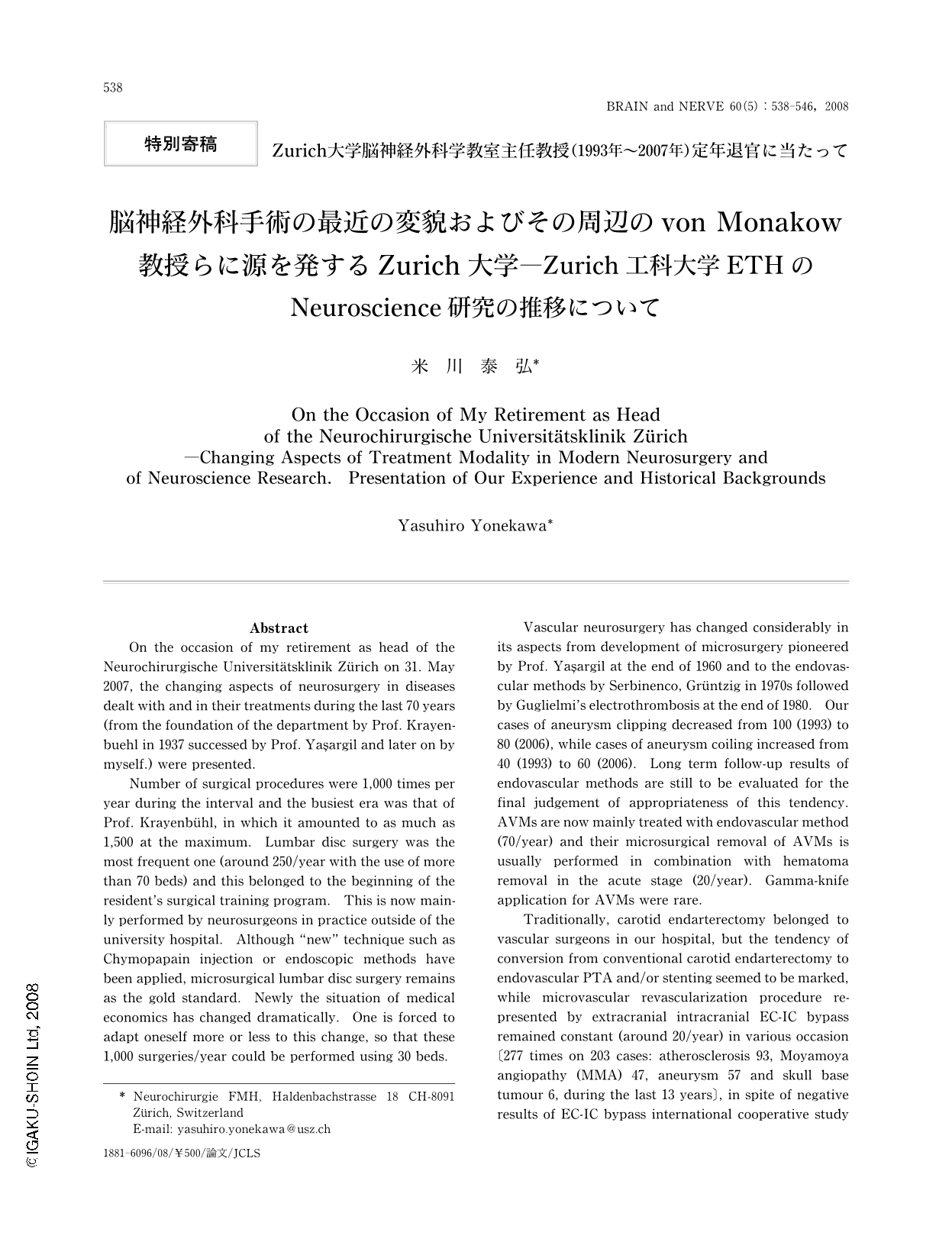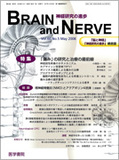Japanese
English
- 有料閲覧
- Abstract 文献概要
- 1ページ目 Look Inside
- 参考文献 Reference
はじめに
私儀
2007年5月31日(木)をもってZurich大学医学部脳神経外科学主任教授を定年退官した。その日はそれまでの毎日とほとんど変わらぬプログラムに終始した。すなわち,私の在任期間を象徴する2つの手術,難治性内側頭葉てんかんmesial temporal lobe epilepsy(MTLE)に対するselective amygdalohippocampectomy(SAHE)と破裂脳動脈瘤のclippingを終えた。その後,病棟回診,さよならの立食パーティー(Apero)で大学病院での活動に終止符を打った。その前後に“Wie hat sich die Neurochirurgische Universitatsklinik Zurich traditionsbewusst gewandelt? Neurologia medicochirurgia Turicencis ―Status praesens―”のタイトルのもとにZurich大学で“さよなら講演”を行ったこと,同じ題で日本でも京都国際会館でかつて一緒に働いた人々にそれぞれ活躍の分野について報告するコンパクトなシンポジウム(Fig.1)を行った。これらの詳細は京都大学脳神経外科同門会報42(2007年)に収載してもらった。
これを機会に厚生省特定疾患ウィリス動脈輪閉塞症調査研究班(班長,1988-1992),日本脳卒中学会(理事,1992),循環器病委託研究費班(班長,1988-1992)などさまざまなかたちでお世話になった日本の(脳神経外科のみでなく)神経科学に携わる先生方に一区切りつけたことの,ないしはお別れのメッセージを届けたい旨を本誌の編集委員の皆さまに伺ったところ,上記のTopicsでとの示唆を頂き快諾を得た。
Abstract
On the occasion of my retirement as head of the Neurochirurgische Universitatsklinik Zurich on 31. May 2007, the changing aspects of neurosurgery in diseases dealt with and in their treatments during the last 70 years (from the foundation of the department by Prof. Krayenbuehl in 1937 successed by Prof. Yasargil and later on by myself.) were presented.
Number of surgical procedures were 1,000 times per year during the interval and the busiest era was that of Prof. Krayenbuhl, in which it amounted to as much as 1,500 at the maximum. Lumbar disc surgery was the most frequent one (around 250/year with the use of more than 70 beds) and this belonged to the beginning of the resident's surgical training program. This is now mainly performed by neurosurgeons in practice outside of the university hospital. Although "new" technique such as Chymopapain injection or endoscopic methods have been applied, microsurgical lumbar disc surgery remains as the gold standard. Newly the situation of medical economics has changed dramatically. One is forced to adapt oneself more or less to this change, so that these 1,000 surgeries/year could be performed using 30 beds.
Vascular neurosurgery has changed considerably in its aspects from development of microsurgery pioneered by Prof. Yasargil at the end of 1960 and to the endovascular methods by Serbinenco, Gruntzig in 1970s followed by Guglielmi's electrothrombosis at the end of 1980. Our cases of aneurysm clipping decreased from 100 (1993) to 80 (2006), while cases of aneurysm coiling increased from 40 (1993) to 60 (2006). Long term follow-up results of endovascular methods are still to be evaluated for the final judgement of appropriateness of this tendency. AVMs are now mainly treated with endovascular method (70/year) and their microsurgical removal of AVMs is usually performed in combination with hematoma removal in the acute stage (20/year). Gamma-knife application for AVMs were rare.
Traditionally, carotid endarterectomy belonged to vascular surgeons in our hospital, but the tendency of conversion from conventional carotid endarterectomy to endovascular PTA and/or stenting seemed to be marked, while microvascular revascularization procedure represented by extracranial intracranial EC-IC bypass remained constant (around 20/year) in various occasion 〔277 times on 203 cases: atherosclerosis 93, Moyamoya angiopathy (MMA) 47, aneurysm 57 and skull base tumour 6, during the last 13 years〕, in spite of negative results of EC-IC bypass international cooperative study for stroke prevention in 1985.
Glioma surgery especially glioblastoma surgery the most frequent surgery in our department around 170 /year contributed to improvement of both life expectancy and quality of life by development of therapy modalities (irradiation microsurgery and chemotherapy). Recent life expectancy of cases with primary glioblastoma amounted to 25.8 ms on the average by combination of treatments; microsurgical gross total removal + irradiation + temodal and thalidomide. This was 8.5 ms and 14 ms respectively at the time of Prof. Krayenbuhl 1960 (surgical removal plus irradiation) and of Prof. Yasargil 1970 (microsurgical removal plus irradiation) and these results being those on cases of primary and secondary glioblastoma together. Postoperative quality of life improved also by using modern techniques: intraoperative stimulation, cortical mapping, navigation, open MRI etc..
Acoustic neurinoma (just less than 20/year) is one of benign brain tumours whose treatment has changed remarkably. Cases were referred to us only when their size exceeded 2-3 cm in extrameatal diameter, as the smaller ones are treated by Gamma-knife. Thanks to development of intaroperative neurophysiological monitoring and of surgical technique, preservation of facial nerve function has improved from 60% to more than 85% in spite of the increase of size.
Functional neurosurgery represented by microvascular decompression for hemifacial spasm and trigeminal neuralgia pioneered by Prof. Jannetta and by the selective amgdalohippocampectomy SAHE for intractable mesial temporal lobe epilepsy MTLE pioneered by Prof. Yasargil both in 1970s were around 20/year respectively. Recently stereotactic intervention decreased remarkably.
Shunting procedure for hydrocephalus malresorptivus (after subarachnoid hemorrhage and/or idiopathic) were around 100/year. Programmable valve (opening pressure can be changed magnetically percutaneously) has increased clinical effectiveness of the shunt.
It was the authors pleasure to have succeeded the Neurochirurgische Universitatsklinik Zurich directed by two foregoing giant neurosurgeons Prof. Krayenbuhl and Prof. Yasargil and therefore to have completed a hard task more or less and have experienced considerable changing aspects of modern neurosurgery as mentioned above.

Copyright © 2008, Igaku-Shoin Ltd. All rights reserved.


